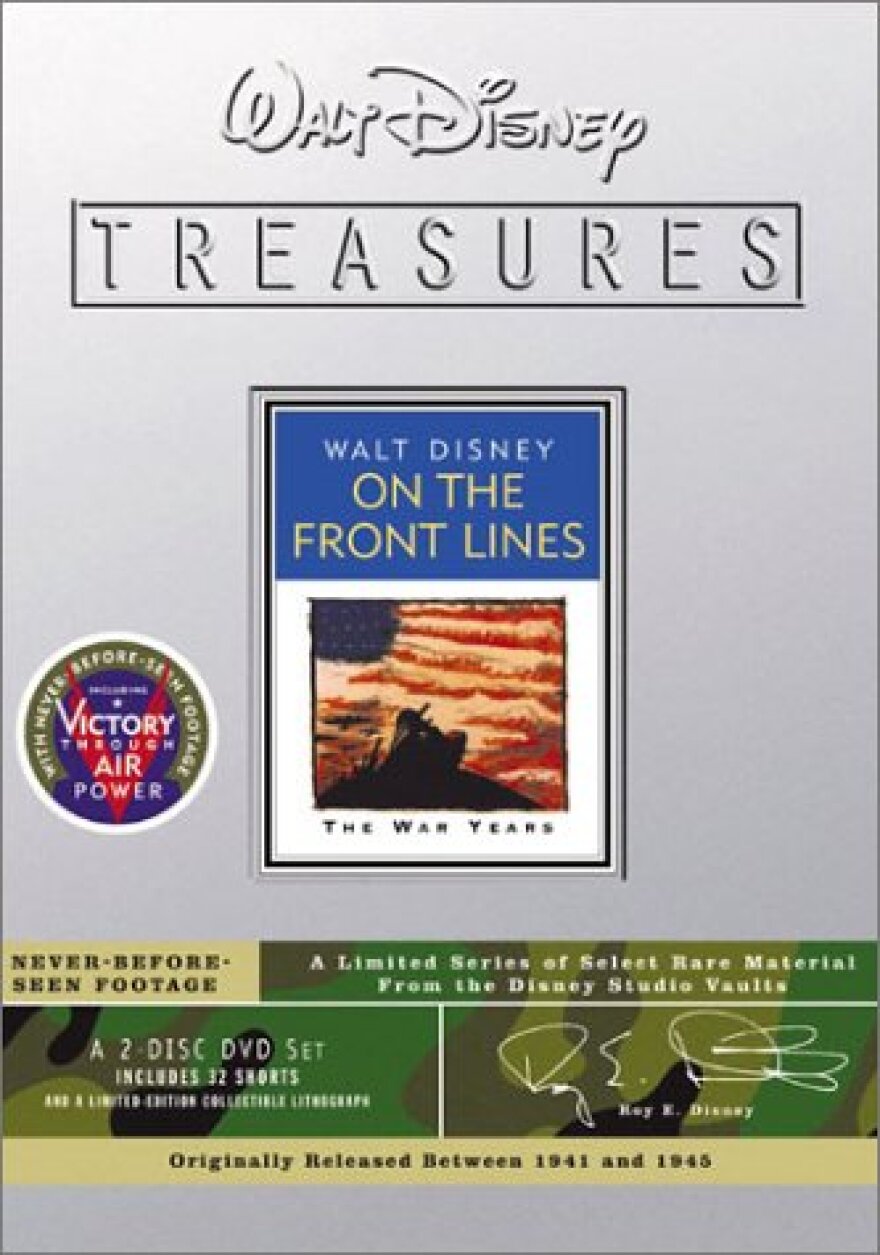The latest series of "Walt Disney Treasures" to be released from the Disney vaults includes DVD sets devoted to Mickey Mouse, Donald Duck, Disney in Space and Beyond, and the much-delayed release of Disney's World War II-era films. The latter has been released as a limited edition (only 250,000 copies) two-disc DVD set, called "Walt Disney on the Front Lines." Long sought by collectors, most of these films were, until now, unavailable to the general public, even in this day and age of the Internet.
On December 8, 1941, the Walt Disney Studios were taken over by the United States armed forces. Work on most of the already scheduled Disney projects slowed, and most of the manpower at the studio was redirected toward producing short films, both animated and live action, for the war effort. These consisted of comical, morale-boosting shorts featuring Disney characters, as well as educational and propaganda shorts and films.
I first heard of the impending release of the Front Lines collection back in 2002, and was eagerly awaiting this set's release. Would these films, so of their time in the early 1940s, be of interest today? The answer, with few exceptions, is yes.

Included on this set are 32 short subjects, several galleries of concept and insignia artwork, interviews with Roy Disney, animators John Hench and Joe Grant, and the full-length feature film "Victory Through Air Power." Donald Duck (who had eclipsed Mickey Mouse in popularity by this time) stars in many of the wartime cartoons, including the famous, and Oscar-winning "Der Feuhrer's Face," wherein Donald has a nightmare about working in a Nazi munitions plant. Poor Donald is forced to march for miles and miles and is frustrated by his pup tent in "Fall Out; Fall In," and gets to bomb a Japanese airfield all by himself in "Commando Duck." Donald also encourages us to "pay our taxes to stop the Axis" in "The New Spirit." It's hard to imagine our government today encouraging us to pay our taxes cheerfully to support a war, so this short gets an extra laugh or two because of its dated nature.
The "educational" shorts included in the set are one or two steps above bone dry in entertainment value, but historically, they are fascinating to watch. I was quite intrigued by "Cleanliness Brings Health," an animated short contrasting the Careless family and the Clean family. Both families are depicted as rural, Hispanic families, and the short shows the devastation that befalls the Careless family when they doesn't bother to clean up, or dig a latrine, wash their hands, or keep tidy. I would love to speak to some of the historians on the Disney lot about shorts like this, to ask who was the target audience for this short. Perhaps it was shown in more agrarian areas of the country.
One more short subject worth noting is "Education for Death: the Making of a Nazi." This short is unlike anything ever produced by the Disney studio, as it follows young Hans as he is indoctrinated into the Nazi ideology in school and in the Nazi army. Using menacing, shadowy images, I can see how the short would effectively scare the bejeezus out of any viewer circa 1943.
The centerpiece of the collection is the 65-minute feature "Victory Through Air Power," a powerful piece of wartime propaganda. Using animation and live action segments, the film's chief goal was to advocate the use of strategic bombing in warfare. It opens with a 20 minute animated "History of Aviation" that is very entertaining, and then moves into the second section of the film, hosted by Major Alexander P. de Seversky. Today, strategic bombing in advance of a surface attack is common, but Seversky's theories were revolutionary at the time. His narration and delivery, combined with the animated illustrations of these theories put into practice, are quite effective in delivering the message in a clear and, dare I say it, inspiring way. It's easy to see how this film, shown to FDR in a 1943 private screening, may have changed the Allies' strategy, and even helped us win the war.

Other features on the set include a couple of rather dry training films illustrating the Disney animators' work, a gallery of sketches and storyboards from the WWII era Disney projects, and most interestingly, the wartime insignia images created by Disney studio artists for use on military aircraft. In this section, you can also discover fun facts like who invented the famous Mickey Mouse cap ears, and the story behind the first Disney signature logo.
Series host Leonard Maltin, a first rate Disney historian, does a good job of putting all of this material in its proper context, though I did tire a bit of seeing him constantly pop up throughout the various features and shorts on the two-disc set.
In all, this "Walt Disney on the Front Lines" is an invaluable resource for historians, teachers, parents, and those wanting to learn about this fascinating time in history, when even Mickey Mouse joined the boys on the front lines. Besides being interesting, the set is incredibly entertaining, too. It's going to occupy a special place on my DVD shelf for many years to come.


